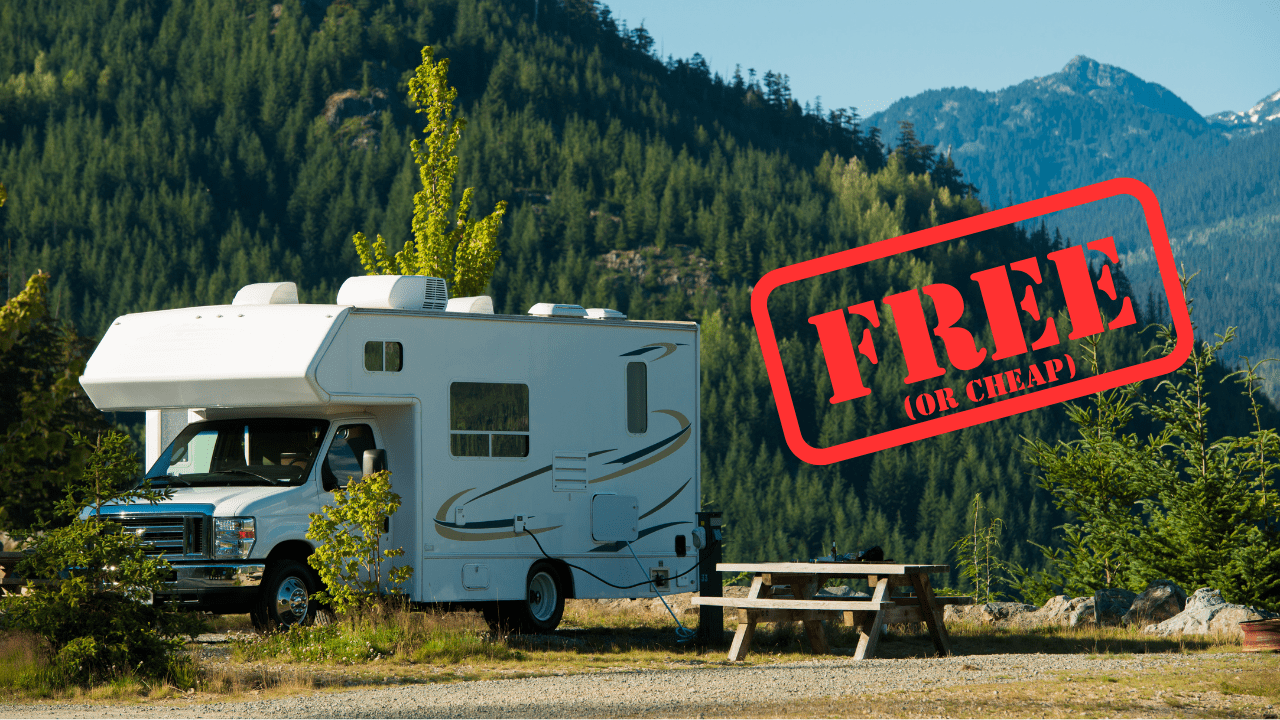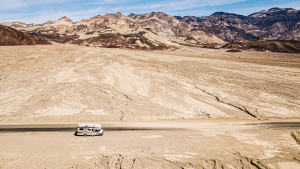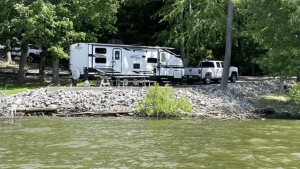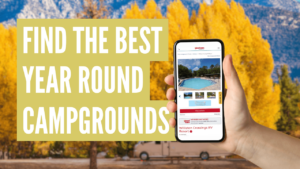If you’re looking to save money or just avoid crowded RV parks, there are a lot of reliable ways to find free or low-cost camping. Here’s a clear breakdown of the best resources and methods that I personally use.
This is a LONG one! So, I’d recommend saving/bookmarking it and coming back to it when needed.
Plus, here are jump links to each section to make navigating the page easier.
- 1. Public Land: BLM and National Forests
- 1.1 BLM Land
- 1.2 National Forests and Grasslands
- 2. U.S. Army Corps of Engineers (COE) Campgrounds
- 2.1 How to Find and Book COE Campgrounds
- 3. National and State Parks
- 3.1 National Parks
- 3.2 State Parks and State Forests
- 4. Helpful Apps and Websites
- 4.1 Campendium
- 4.2 The Dyrt
- 4.3 ReserveAmerica
- 4.4 FreeCampsites.net
- 4.5 AllStays
- 5. Membership Options That Save Money
- 5.1 Harvest Hosts
- 5.2 Boondockers Welcome
- 5.3 RV Overnights
- 5.4 Passport America
- 5.5 Thousand Trails
- 6. Short-Term Free Overnight Parking
- 6.1 Walmart
- 6.2 Cracker Barrel
- 6.3 Cabela’s and Bass Pro Shops
- 6.4 Truck Stops
- 6.5 Rest Areas
- 6.6 Casinos
- 7. Local and County Parks
- 7.1 How to Find Them
- 7.2 Benefits
Public Land: BLM and National Forests
A big portion of free or cheap RV camping is on government-managed land. Two of the main agencies that allow it are the Bureau of Land Management (BLM) and the U.S. Forest Service. These areas are open to the public and often allow what’s called dispersed camping, which means camping outside of developed campgrounds. You won’t have hookups, but you also won’t have to pay.
BLM Land

The Bureau of Land Management oversees about 245 million acres, mostly in the western U.S. This land is used for a mix of things like grazing, mining, recreation, and camping. Most of the time, you can stay up to 14 days in one spot within a 28-day period.
To find BLM sites:
- Go to Recreation.gov and search near your destination.
- Use filters for “Camping” and “RV/Motorhome” under “Allowable Equipment.” That helps remove the listings that don’t work for your setup.
- You might see mostly reservable group sites. If that’s the case, don’t stop there. A lot of BLM land is first-come, first-served, and not listed on reservation sites.
- Cross-check the area using Campendium. Use the filters to show public land and set the price range to $0–$30. You’ll get a mix of free and low-cost listings, with photos, reviews, GPS coordinates, and cell coverage info.
Tip: Cell signal can be spotty in some of these areas, so it’s a good idea to write down coordinates or save the map offline before heading out.
National Forests and Grasslands
The U.S. Forest Service manages 154 national forests and 20 national grasslands covering over 190 million acres across the country. Most allow dispersed camping unless signs say otherwise. The usual stay limit is also 14 days.
To figure out where you can camp:
- Use the USFS website or the USFS mobile app (iOS) / Google Play. You’ll find maps, campsite listings, and other useful info like what roads are open or closed.
- Stop by a local ranger station when you’re nearby. Rangers can give you Motor Vehicle Use Maps (MVUMs) that show roads and areas where dispersed camping is allowed. They’ll also tell you about fire restrictions or any local rules.
- Some people like using Benchmark Maps, which are physical atlases with detailed layouts of public lands. They’re helpful when you’re in areas with no signal.
A lot of national forests also have developed campgrounds, and many of those are inexpensive. Some don’t have hookups, which makes them cheaper. If you’re willing to go without hookups for a few days, you’ll have more choices and lower costs.
Tip: What I like to do is stay a few days at a free spot and boondock it, then stay at a paid campsite with full hookups to empty my waste tanks and fill up with water. Over a week or two, the savings really add up!
U.S. Army Corps of Engineers (COE) Campgrounds
The U.S. Army Corps of Engineers manages over 450 public campgrounds across 43 states. These are often located near lakes, rivers, and reservoirs the Corps has built or maintains for flood control, navigation, and recreation. The campgrounds are well-kept, usually quieter than commercial RV parks, and generally more affordable.
Most COE campgrounds have basic amenities like:
- Designated RV sites (some with pads)
- Picnic tables and fire rings
- Potable water and restrooms
- Dump stations
- Boat ramps or lake access (at many locations)
They usually don’t offer full hookups, but many sites have electric and water. Prices typically range from $10 to $30 per night, depending on the site and amenities. Some campgrounds also offer discounts for seniors with the America the Beautiful Senior Pass (usually 50% off).
How to Find and Book COE Campgrounds
1. Use Recreation.gov
The best place to book is Recreation.gov. You can search by campground name or location and filter for RV-friendly sites. Most COE sites are reservable, though some have first-come, first-served loops.

- Go to the main site or app
- Enter a location or search term like “COE campground”
- Use filters for “RV/Motorhome” under allowable equipment and “Electric Hookups” if needed. There’s also a filter for COE Campgrounds under the “Additional Preferences” section in the filter list.
- Check site length before booking to make sure your RV will fit
2. Use the COE Guidebook (Optional but Helpful)
There’s a book called Camping with the Corps of Engineers by Don Wright. It lists every COE campground in the U.S. with directions, descriptions, and basic amenity info. Some info may be outdated since the last edition came out before 2020, but it’s still a solid reference, especially when planning routes.
3. Use Other Tools to Preview Sites
Before booking, you can preview campground layouts, photos, and reviews using:
These sites often show GPS coordinates, cell service quality, user reviews, and which rigs have fit there.
4. Annual Day Use Pass (Optional)
Some COE locations charge day-use fees even if you’re not camping. If you visit these areas often, you can get a COE Annual Pass for $40, which covers day-use areas like boat launches and swimming beaches. This pass does not cover camping fees.
National and State Parks
National and state parks offer some of the most scenic campgrounds you can find, and while not usually free, many are reasonably priced. If you’re okay going without hookups, you can often find cheaper sites, especially in the off-season or in first-come, first-served loops.
National Parks

There are over 60 U.S. National Parks managed by the National Park Service (NPS). Most have at least one developed campground, and many offer dry camping or partial hookup sites. Prices vary but are generally between $10 and $35 per night. Many even offer free sites for those looking to boondock.
How to find and book:
- Go to Recreation.gov to find reservable National Park campgrounds. You can search by park name and apply filters like “RV/Motorhome” and length requirements.
- Some campgrounds don’t take reservations. For those, it’s best to arrive before 11 AM, especially during peak season.
- For non-reservable and complete campground listings, check the official NPS website. Click your park, then go to “Plan Your Visit” → “Things to Do” → “Camping” to view all available options.
Be aware that many National Park campgrounds have length restrictions. Sites may only accommodate RVs 20–40 feet, and large rigs might have trouble with narrow or winding roads. Some parks also have no hookups at all.
If you’re a senior, the America the Beautiful Senior Pass gives you a 50% discount on camping at most federally managed sites, including National Parks.
State Parks and State Forests
Every state runs its own park system, so you’ll need to look at each state’s individual website for campground listings and reservations. Prices are typically lower than National Parks, usually around $18 to $28 per night in State Parks, and $5 to $20 per night in State Forests.
Where to look:
- Start with a search like “[Your State] State Park Camping” to find the official parks website. For example, Florida State Parks or California State Parks.
- Some states use their own booking platforms (like ReserveAmerica or state-specific systems). Others also list availability on Campendium or The Dyrt, where you can preview campground conditions and reviews.
- Wand’rly Magazine also has a summary of state park campgrounds organized by state, including cost and available hookups.
Some state parks also offer first-come, first-served sites or seasonal discounts. If you’re flexible with dates and locations, there are often open spots even when reservable ones are booked out.
Helpful Apps and Websites

When it comes to finding campsites, managing your reservations, or just looking for a place to stay on the road, there are a lot of useful apps and websites to help you. These tools can make it easier to find spots that meet your needs, whether you’re looking for a site with hookups or something more rustic.
Campendium
Campendium is a popular app and website for finding campgrounds across the U.S. It includes both free and paid sites, from National Parks to hidden gems in the wilderness. Campendium offers reviews from other campers, making it easy to gauge the quality of the site before booking.
You can filter searches by amenities like “free camping,” “pet-friendly,” and “cell service.” The user reviews are especially helpful in determining things like accessibility, road conditions, and any hidden fees.
How to use:
- Download the app from the App Store or Google Play.
- Use the search bar to look for campgrounds by location or by specific amenities.
The Dyrt
The Dyrt is another great platform for discovering campgrounds. What sets it apart is its large database of user-submitted reviews, which include detailed information about amenities, noise levels, proximity to water, and more.
The Dyrt’s premium subscription, called The Dyrt PRO, gives you access to offline maps, more filtering options, and additional campground photos. This can be especially useful in areas where cell service is spotty.
How to use:
- Visit the website or download the app from the App Store or Google Play.
- Search by state, campground name, or the type of experience you want, like “boondocking” or “RV hookups.”
ReserveAmerica
For campgrounds in state and national parks that require reservations, ReserveAmerica is one of the best resources. It’s an official site used by many state parks and provides an easy way to reserve your spot online. Many state parks use ReserveAmerica to handle all their reservations, and you can search by location, available dates, and amenities.
How to use:
- Go to the ReserveAmerica website or download the app from the App Store or Google Play.
- You can view campgrounds by type and make reservations directly from the app.
FreeCampsites.net
If you’re looking for free camping options, FreeCampsites.net is a go-to website. It provides a list of free campsites across the U.S. and Canada, including national forests, Bureau of Land Management (BLM) lands, and more. You can filter by amenities and check reviews from others who have stayed at each site.
Visit the FreeCampsites.net website for details on campgrounds.
AllStays
AllStays is a paid app that offers a comprehensive database of RV parks, campgrounds, rest areas, and other types of camping spots. You can filter searches by amenities, price range, and even check for spots with available cell phone signal. It’s particularly helpful for RVers, as it includes details about pull-through sites and dump stations.
How to use:
- You can get the AllStays app, which there are actually several, from the App Store
- The app offers a one-time purchase for premium features or a free version with limited access.
Membership Options That Save Money

If you camp often, a few paid RV memberships can help lower your overall costs. These aren’t free, but the yearly fee can pay for itself quickly if you use them regularly. Most give you access to places that aren’t listed on traditional booking sites.
Harvest Hosts
Harvest Hosts gives you access to stay overnight at wineries, breweries, farms, museums, and other small businesses across the U.S. and Canada. There are no overnight fees, but you’re expected to support the business by making a small purchase, like a bottle of wine or local produce.
- Over 9,000 host locations
- Stays are typically one night
- Membership info (plans vary by access level)
Boondockers Welcome
Boondockers Welcome connects you with private property owners who allow free overnight RV parking on their land. Hosts are usually RVers themselves and offer stays of 1–5 nights.
- Over 3,300 hosts
- You can search by location and filter by RV size, pets, and more
- Now part of Harvest Hosts, but it remains a separate membership
- $79-$179 annually
RV Overnights
RV Overnights is a newer platform offering access to businesses like farms, attractions, and restaurants that allow overnight RV parking. It’s similar to Harvest Hosts, but less expensive and includes more host categories.
- $49/year membership
- Some hosts allow multiple nights
- Suggested minimum purchase of $30 per stay
Passport America
Passport America gives you 50% off the regular nightly rate at participating campgrounds. The network includes over 1,200 locations, mostly smaller RV parks.
- Annual membership is around $44
- Discounted stays usually have limits (e.g. only valid Mon–Thu, or for 1–2 nights)
- Not all locations are in popular tourist areas, but it can work well on travel days
Thousand Trails
Thousand Trails offers access to a network of private campgrounds. They have regional memberships as well as national ones. You pay a flat annual fee, and stays are free after that (though some locations charge extra for premium sites).
- Large network of private campgrounds, mostly in the U.S.
- Stay up to 14 days at a time with a basic membership
- Higher tiers allow longer stays and more zones
- Works best for full-time RVers or frequent travelers
Short-Term Free Overnight Parking

These options are useful when you just need a place to sleep for the night and don’t need a full campground. Most are designed for overnight parking, not extended stays, and usually don’t allow slide-outs, leveling jacks, or setting up camp.
See what stores actually allow overnight RV parking for the full list.
Walmart
Many Walmart locations still allow RVs to park overnight for free. Policies vary by location and are sometimes restricted due to city ordinances.
- Always check with the store manager first.
- Park at the far edge of the lot and avoid blocking traffic.
Here are 10 Must-Follow Rules of Overnight RV Parking at Walmart if you plan to stay overnight at one of their locations.
Cracker Barrel
Cracker Barrel restaurants often welcome RVs to stay overnight in their parking lots (even though corporate says they don’t). Many locations have long designated RV/bus spots.
- Ask the store manager for permission.
- Most locations are close to highways and easy to access.
- Quiet and typically safer than truck stops.
Cabela’s and Bass Pro Shops
Many Cabela’s and Bass Pro Shops locations are RV-friendly and allow overnight parking.
- Some offer dump stations and potable water (varies by location).
- Use FreeCampsites.net or Campendium to check reviews.
- Always ask store management before parking.
Truck Stops
Places like Love’s, Pilot Flying J, and TA Travel Centers allow overnight RV parking in designated spots.
- Designed for big rigs, so maneuvering space is usually not a problem.
- Expect some noise from idling trucks.
- Good option for a quick overnight during long travel days.
Rest Areas
Many state-run rest areas allow RVs to stay overnight, but laws vary by state.
- Some allow parking for up to 8–24 hours; others prohibit overnight sleeping entirely.
- You’re parking, not camping, which means no awnings, grilling, or setting up chairs.
- Use the state’s DOT website or signs on-site for rules.
Casinos
Many casinos have large parking lots and allow RVs to stay overnight for free or for a small fee.
- Often have security patrols and access to restaurants or restrooms.
- Some require you to check in with security or player’s club.
- Use CasinoCamper to find participating locations.
Local and County Parks
Local and county-run parks are often overlooked when searching for RV camping, but they can be a great way to find affordable spots, sometimes even cheaper than state parks. These campgrounds are typically run by city governments, county park departments, or regional recreation areas.
- Prices usually range from $10 to $25 per night.
- Many offer basic amenities like restrooms, electric hookups, picnic tables, and dump stations.
- Sites are often less crowded and quieter than larger parks.
- Some parks don’t take reservations and operate on a first-come, first-served basis.
How to Find Them
Since these parks often don’t show up on big apps like Recreation.gov, you’ll need to do a bit of digging.
Search tips:
- Use search phrases like:
- “RV camping [county name]”
- “[town name] city park campground”
- “campground site:[.gov] [state]”
- Look for the county’s official website or parks and recreation department. For example:
Helpful tools:
- Campendium – Some county parks are listed here with reviews.
- FreeCampsites.net – Includes user-submitted local and municipal parks.
- Google Maps – Zoom in on green park icons near smaller towns and click around to see if they mention RV camping.
Benefits
- They’re usually less trafficked than state and national parks.
- More flexible for last-minute trips.
- You’re often closer to small-town amenities like grocery stores or laundromats.
If you’re traveling through rural areas or smaller towns, it’s worth checking to see if there’s a local park with RV accommodations. Many travelers miss these simply because they don’t show up on the major booking sites.
Hopefully, this helps you find some great spots to stay without breaking the bank. If you know of any other free or low-cost RV camping options that weren’t mentioned, let me (and the readers) know in the comments. We’d love to hear about them.







Write a comment